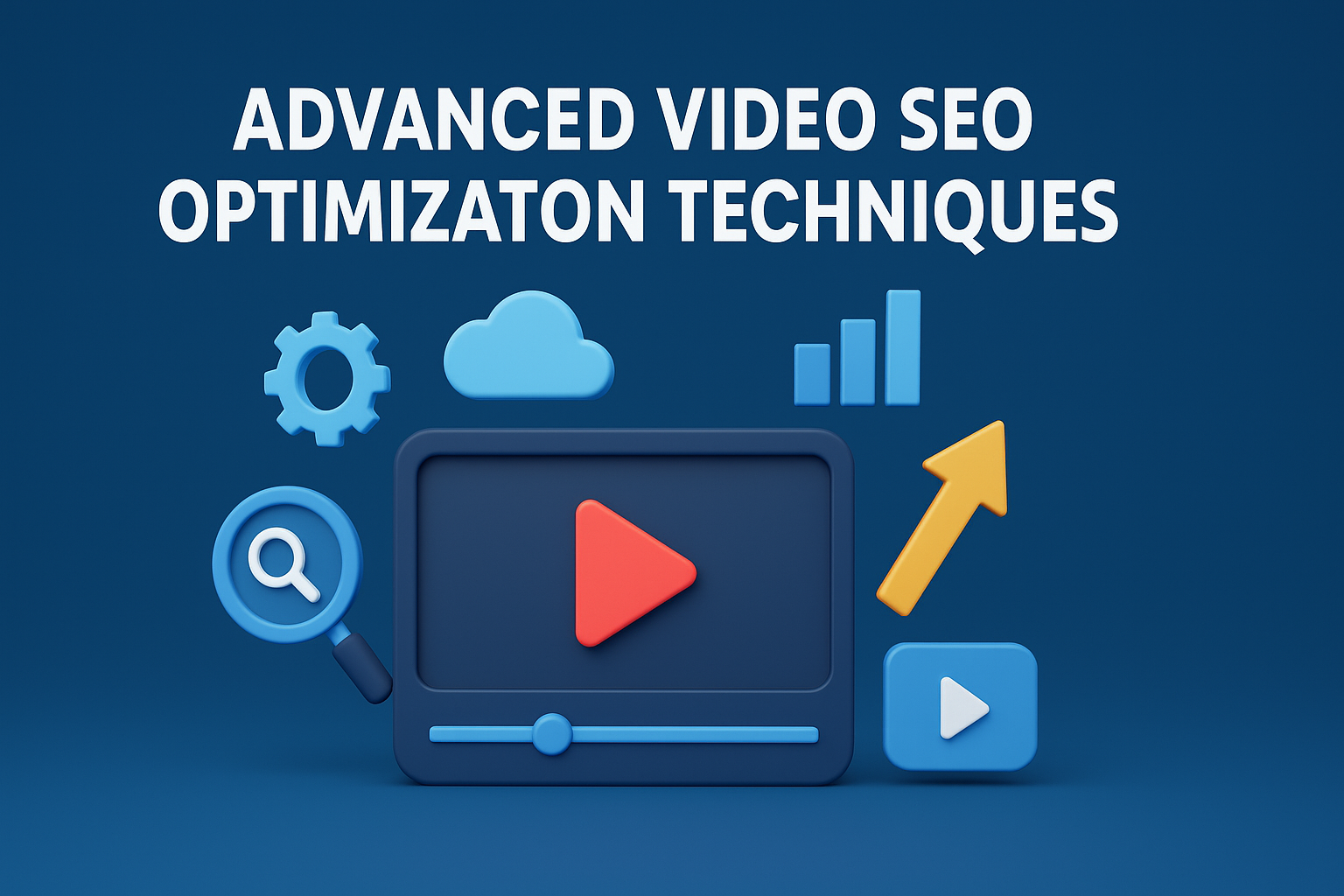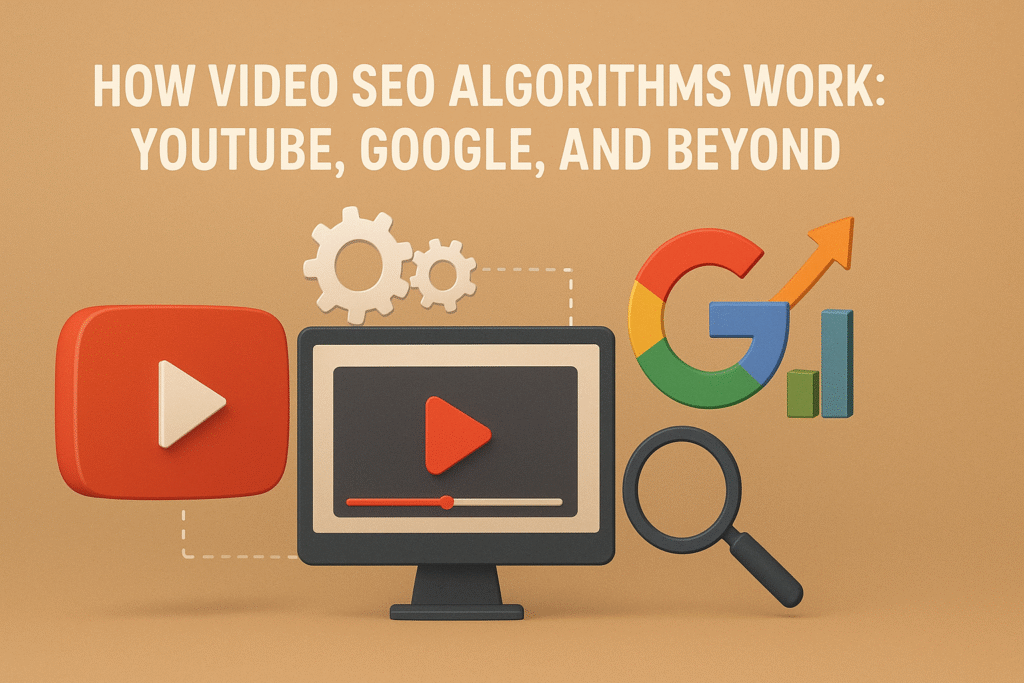In today’s digital era, video content isn’t just another marketing asset — it’s the centerpiece of how audiences consume information online. Whether it’s YouTube tutorials, product explainers, or short-form clips on social platforms, video now dominates online engagement. But with millions of videos uploaded daily, standing out requires more than creativity; it requires strategy. That’s where video SEO comes in. Understanding how video SEO algorithms work is crucial because every platform — from Google to YouTube — has its own way of analyzing and ranking videos. In this guide, we’ll explore the algorithms that power video rankings, the key optimization techniques that matter most, and how you can make your videos perform better across every major platform.
So, what is video SEO and how it works exactly? In simple terms, video SEO refers to the process of optimizing your video content so it ranks higher on search engines like Google and platforms like YouTube. It helps your videos appear when users are searching for topics related to your niche, ultimately increasing visibility, clicks, and engagement.
Table of Contents
Understanding the Basics of Video SEO
Before diving deeper into Video SEO algorithms, let’s clarify the foundation. Traditional SEO focuses on optimizing web pages for search engines using keywords, backlinks, and technical signals. Video SEO, on the other hand, revolves around optimizing video elements like titles, descriptions, thumbnails, engagement signals, and video metadata.
The goal remains the same — to improve discoverability — but the execution differs.
Core Components of Video SEO
- Metadata Optimization – Titles, tags, and descriptions that clearly convey what your video is about.
- Engagement Metrics – Watch time, likes, shares, and comments signal quality to algorithms.
- Visual Appeal – Thumbnails and on-screen clarity attract viewers and increase click-through rates.
- Transcripts and Captions – Help both accessibility and keyword indexing.
- Video Placement – Hosting on the right platform and embedding strategically on your website.
When you understand what is video SEO and how it works, you’ll see that these factors collectively help search engines interpret your content’s value and relevance — leading to better rankings and more organic traffic.
How Google Ranks Video Content in Search?
Google’s search engine doesn’t just rank web pages; it also identifies and prioritizes videos when they are the most relevant form of content for a user’s query.
1. Crawling and Indexing
Google crawlers use structured data and sitemaps to identify video content. If your webpage includes a video, Google needs proper markup (like VideoObject schema) to understand what the video contains. Without this, even great videos might not appear in search results.
2. Structured Data and Schema Markup
Adding schema markup tells Google key details about your video — title, duration, upload date, and description. It helps your video qualify for rich snippets and appear in the “Videos” tab or SERP carousel.
3. Engagement and Relevance
Google measures how users interact with your video. If viewers click your result, stay to watch, and engage, Google interprets that as quality content. These behavioral signals are part of the algorithm’s decision-making process.
4. Technical Optimization
Page speed, mobile responsiveness, and the presence of an embedded video all play roles. A slow or unoptimized page can affect how Google perceives your video’s quality.
If you truly want your videos to dominate, remember — Google ranks not just based on relevance but also on user experience and engagement depth.
How YouTube’s Algorithm Works for Video SEO?
YouTube’s Video SEO algorithms is one of the most advanced systems for analyzing user intent and engagement. It’s designed to keep viewers on the platform as long as possible — and your video’s success depends on how well it contributes to that goal.
Key Ranking Signals
- Watch Time: The total amount of time viewers spend watching your video. Longer watch times indicate quality content.
- Click-Through Rate (CTR): The percentage of people who click your video after seeing its thumbnail or title.
- Audience Retention: Measures how long viewers stay before leaving.
- Engagement: Likes, comments, and shares signal positive viewer experience.
Metadata Optimization
Your title and description should include your target keywords but feel natural and conversational. Tags, while less critical today, still help categorize your content. Adding transcripts and closed captions allows YouTube to better understand your video’s context and content.
Personalization
YouTube’s recommendation engine tailors suggestions based on each user’s viewing history. This means your video might rank differently for different viewers depending on their behavior.
When you fully grasp what is video SEO and how it works within YouTube’s ecosystem, you can align your video content with what the algorithm rewards — consistent engagement, relevance, and audience satisfaction.
The Connection Between YouTube SEO and Google SEO
Although YouTube operates as its own platform, it’s owned by Google — meaning there’s a powerful overlap between the two. In many search queries, Google often displays YouTube videos at the top, especially for “how-to,” tutorials, and reviews.
How They Work Together?
- Google trusts YouTube’s data because it’s reliable and engagement-driven.
- YouTube videos embedded on websites can increase dwell time — a ranking factor for Google.
- Optimized YouTube titles and descriptions with keyword consistency can improve both YouTube and Google rankings.
For a brand or creator, optimizing for both platforms amplifies reach. You’re not just visible within YouTube — you’re also capturing organic traffic directly from Google SERPs.
Beyond YouTube — Other Platforms and Their Algorithms
While YouTube dominates Video SEO algorithms, it’s not the only platform that matters. Every major platform has its own algorithm that values specific engagement metrics.
Vimeo
Focuses on high-quality video and creative storytelling. Engagement rate and viewer completion matter most.
TikTok
Its Video SEO algorithms relies heavily on user behavior — likes, shares, replays, and completion rate determine visibility.
Instagram Reels
Prioritizes fresh, engaging, and short-form content. Keywords in captions and audio also affect discoverability.
LinkedIn Video
Rewards videos that drive meaningful engagement and professional conversations.
Diversifying across platforms gives you algorithmic leverage. Each one feeds discovery signals that strengthen your overall brand visibility.
Technical Aspects of Video SEO Algorithms
To fully understand what is video SEO and how it works, it’s important to explore the technical side of optimization.
1. Video Sitemaps
A video sitemap helps search engines find and index videos across your site. It contains essential details like video title, description, and thumbnail URL.
2. Schema Markup
Structured data helps Google identify your video type — tutorial, review, or product demo — making it easier to appear in relevant searches.
3. File Optimization
Compressing your video without losing quality improves load times. Fast-loading videos enhance both user experience and ranking potential.
4. Captions and Subtitles
Text transcripts make videos accessible and searchable. They also help with indexing since search engines can’t “watch” videos the way humans do.
5. Mobile Responsiveness
With most users consuming video on mobile, ensuring adaptive video playback is a must.
Advanced Video SEO Optimization Techniques

As Video SEO algorithms evolve, video SEO now involves more advanced strategies that blend content creation with analytical precision.
Keyword Research for Video SEO
Tools like Google Keyword Planner, TubeBuddy, or vidIQ help identify terms people are searching for. Integrate your primary keyword — what is video seo and how it works — naturally within your metadata.
Optimizing Thumbnails
A strong thumbnail with clear visuals and contrasting colors boosts CTR and signals relevance to Video SEO algorithms.
Timestamps and Chapters
Organize your content into segments using timestamps. This improves user navigation and allows Google to highlight key moments in SERPs.
Analytics and Refinement
Regularly analyze performance metrics like audience retention and watch time to adjust future uploads.
AI Tools
Modern SEO tools powered by AI now provide insights into what type of visuals, tones, or keywords perform best for specific audiences.
Common Mistakes That Hurt Video SEO Performance
Even small missteps can reduce visibility. Avoid these common errors:
- Skipping keyword optimization in titles or descriptions
- Using irrelevant or clickbait thumbnails
- Forgetting to add schema or transcripts
- Ignoring mobile viewers
- Uploading poor-quality or unengaging videos
Remember, Video SEO algorithms reward consistency and authenticity. Staying aligned with best practices ensures steady growth over time.
How to Measure the Success of Your Video SEO Efforts?
Tracking your performance helps you understand whether your optimizations are working.
1. YouTube Analytics
Monitor metrics like watch time, CTR, audience retention, and engagement.
2. Google Search Console
Check which queries your video pages are ranking for, and how users interact with them.
3. KPIs to Watch
- Impressions
- Average view duration
- Click-through rate
- Engagement ratio (likes/comments per view)
4. A/B Testing
Experiment with different thumbnails, titles, and video lengths to identify what works best. Data-driven decisions help refine your video SEO strategy and maximize returns.
The Future of Video SEO Algorithms
Video SEO continues to evolve as technology and user behavior change.
1. AI and Machine Learning
Video SEO algorithms increasingly rely on AI to interpret visual and audio content. They can now identify topics, sentiments, and even product mentions within videos.
2. Voice and Visual Search
As voice search grows, optimizing your video titles and transcripts for conversational keywords will become crucial.
3. Predictive SEO
Future Video SEO algorithms may predict content relevance before it even trends — rewarding early adopters. Understanding these future directions helps you stay one step ahead in the video SEO game.
Conclusion
Mastering what is video SEO and how it works isn’t just about adding keywords or optimizing thumbnails — it’s about understanding how algorithms interpret the value.
Google and YouTube use engagement, context, and technical signals to decide which videos deserve visibility. When you align your content with these principles — focusing on clarity, audience satisfaction, and accessibility — your videos naturally rise through the ranks.
The more you understand these algorithms, the more control you gain over your digital visibility.
FAQs
1. What exactly is video SEO and how it works in digital marketing?
Video SEO helps your videos rank higher in search results by optimizing metadata, engagement, and accessibility.
2. How do I make my videos rank higher on YouTube and Google?
Focus on keyword optimization, engagement metrics, schema markup, and consistent uploads.
3. Is video SEO different from regular SEO?
Yes. While both aim to improve visibility, video SEO focuses specifically on video-specific signals like watch time, retention, and metadata.
4. How important are tags and transcripts in video SEO?
They help search engines understand your video’s topic and improve accessibility.
5. Can video SEO help increase website traffic?
Absolutely. Embedded and optimized videos can attract more users and keep them longer on your site.
6. What tools are best for analyzing video SEO performance?
Use YouTube Analytics, Google Search Console, and AI-driven tools like TubeBuddy or vidIQ.



